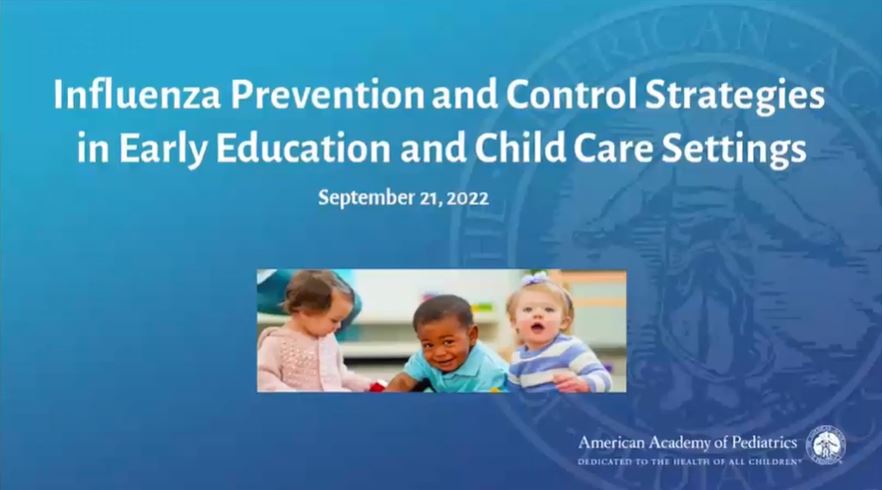Influenza is a serious threat to individuals, especially to children. Children have the highest rates of influenza infections and are more likely to become severely ill. Children younger than 5 years of age (especially those younger than 2) and children with certain underlying medical conditions are at an increased risk of hospitalizations and complications from influenza. These groups of children are more vulnerable, as they have immature immune systems, are in the developmental phase (eg, exploration of objects and putting objects in their mouth), or may not be old enough to be vaccinated (ie, younger than 6 months of age).
Strategies to Implement for the Influenza Season
The influenza virus is highly contagious, and children play a vital role in its transmission. They are more likely to spread it to their household members and other close contacts, such as teachers and other children. Therefore, implementing strategies to prevent and control influenza in early education and child care is important.
Use the following strategies within your early education and child care program:
- Encourage regular hand washing. Hand washing is the preferred method to prevent the spread of germs and viruses.
- Refer to this Healthy Children article on hand washing for more information.
- Utilize infection prevention and control methods as recommended in Caring for Our Children.
- Clean, sanitize, and disinfect surfaces.
- Teach children to cough and sneeze in their elbows.
- Make sure rooms are well-ventilated.
- Be an advocate and remind parents about getting themselves and their children vaccinated.
- Send out reminders.
- Provide education resources about influenza vaccination.
- Use resources from AAP’s Flu Toolkit.
- Encourage families to see their pediatrician.
- Recommend influenza vaccination to all staff and promote the importance of being vaccinated in early education and child care programs.
- Improve vaccination access for staff with on-site immunizations or scheduled time off.
- Make annual influenza vaccination part of the routine.
- Exclude a child during influenza season (when influenza is known to be prevalent in the community) if the child has a fever and behavior change or fever with other signs or symptoms of influenza illness, like cough, sore throat, sneeze, or runny nose, and is unable to participate in activities and requires extra care.
- Refer to the Quick Reference Sheets chapter in the Managing Infectious Disease book for more information.
- Have an emergency plan in place for seasonal and pandemic influenza, and in case of an outbreak at your center.
- Prepare ahead to protect your center in an emergency. This helps save lives and reduces adverse consequences.
- Ensure alternative plans are in place in case of supply shortages, staff shortages, and possible closures.
- Refer to the pandemic influenza and emergency preparedness resources below.
Watch the webinar on Influenza Prevention and Control Strategies in Early Education and Child Care Settings below to learn more about how to prevent and control the spread of influenza. Presentation slides are available here.

Influenza Prevention and Control Strategies in Early Education and Child Care Settings
Resources
Best Practices and Managing Infectious Diseases
- Caring for Our Children (CFOC) | National Resource Center - CFOC is a collection of national standards that represent best practices, based on evidence, expertise, and experience, for quality health and safety policies and practices for today’s early care and education settings. CFOC includes standards for Health Promotion and Protection and Infectious Diseases.
- Managing Infectious Diseases in Child Care and Schools, 5th Edition (Note: purchase required) - This guide provides child care directors, teachers, and caregivers with essential information on the prevention and management of infectious diseases in group care settings.
Pandemic Influenza and Emergency Preparedness
- Guide for Creating a Pandemic Influenza Plan – Use this guide to create a pandemic influenza plan for early education and child care settings.
- Emergency Preparedness Manual for Early Childhood Programs – This manual provides information to assist early education and child care programs with making emergency plans to help keep their settings safe before, during, and after an emergency, such as an influenza outbreak or pandemic.
Healthy Children | AAP
- Find AAP Healthy Children resources on disease prevention strategies.
- Find AAP Healthy Children influenza subsites in English and Spanish for more information.
Information for Schools & Childcare Providers | CDC
- Find CDC resources and information on influenza prevention and control for schools and child care providers.
Last Updated
10/26/2022
Source
American Academy of Pediatrics